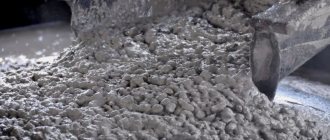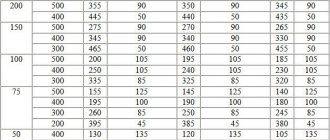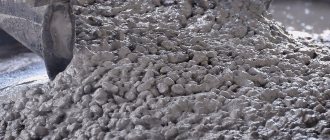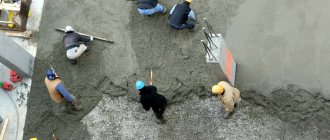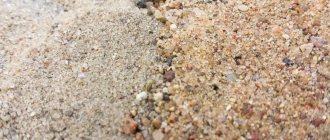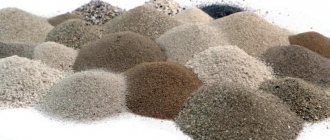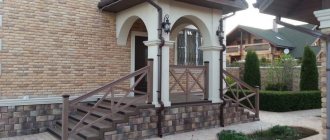The construction of modern buildings and structures is difficult to imagine without the use of concrete mixtures used in monolithic and reinforced concrete structures. Durable artificial stone materials of natural origin - concrete B 25, has gained enormous popularity and is widely used in road construction, bridge construction, construction of hydraulic structures and other civil and industrial facilities.
Concrete mixture B 25 in finished form Source sovet-sadovody.ru
Scope of application
In construction, heavy concrete class B 25 is used in the creation of load-bearing structures of buildings and structures operating under conditions of significant operational loads and impacts:
- Construction of load-bearing foundations. The concrete mixture is excellent for pouring monolithic strip, columnar, slab and pile-grillage foundations of any configuration.
- Monolithic housing construction in low-rise construction.
- Arrangement of parking lots for cars and trucks.
- In factory conditions for the production of prefabricated reinforced concrete elements: floor and roof slabs, window and door lintels, columns, crossbars and purlins.
- In construction, for pouring monolithic reinforced floor slabs between floors.
- Construction of underground parking lots, pedestrian crossings, sewer collectors.
- Construction of blind areas, ramps and platforms for private and multi-storey buildings.
Construction of a reinforced concrete slab made of heavy concrete Source googleapis.com
Concrete grade b 25 is used for the construction of industrial facilities, shopping and entertainment centers, social and cultural buildings and other structures.
Why should you choose concrete in Tver
Concrete offers various grades of concrete. In addition to direct production, we ensure delivery of the material to the construction site, taking into account the pouring time. Quality is confirmed by certificates of conformity.
Do you want to buy concrete in Tver or the Tver region at affordable prices? Then we are waiting for your message or call. Our operators will provide all the necessary information on our products, delivery, terms of sale of crushed stone and sand, rental of concrete pumps. We work around the clock, 24/7. We accept calls and place orders on weekends and holidays.
Main technical characteristics
The diverse demand and wide popularity of concrete 25 is explained by the successful combination of excellent technical characteristics and mechanical indicators:
- The compressive strength indicator is 25 MPa, which corresponds to concrete grade 350. This technical parameter determines the maximum maximum load that one cube of concrete can withstand before destructive deformations begin to appear.
- The mobility of the concrete mixture is P 2 – P 4. The level of mobility of class 25 concrete can be changed by introducing various plasticized additives into the solution.
Plasticity of concrete mixture Source honeyblackmagazine.com
See also: Catalog of companies that specialize in calculation, installation and repair of foundations
- Water resistance W 8. The technical characteristic of water resistance indicates the ability of the material not to allow water to pass through a concrete structure under conditions of high water pressure. The W 8 index significantly expands the functional use of the mixture: concrete of this grade can be used for load-bearing structures of foundations with a high level of groundwater.
- Frost resistance F 200 – F 300 indicates the ability of the material to maintain its structural integrity and strength characteristics during cyclic freezing and thawing. Concrete 25 can withstand up to 300 such cycles, which makes it an indispensable material for the construction of buildings and structures in harsh climatic conditions.
The volumetric weight of concrete with crushed granite aggregate is from 2200 to 2400 kg/m³.
Comparative table of volumetric weight of heavy concrete Source eyecorrector.ru
How concrete is marked for frost resistance and water permeability
In addition to strength, concrete is also characterized by other parameters that have their own brand designation. These parameters include water resistance and frost resistance. The water resistance indicator is denoted by the letter - W, and the frost resistance indicator - F. These indicators are often not taken into account when choosing a concrete grade, especially for the construction of low-rise buildings.
The frost resistance index of concrete is characterized by maintaining the number of freezing-defrosting cycles, without reducing its original strength. The standard designation of concrete in terms of frost resistance is: F50, F75, F100, F150, F200, F300, F500. Almost 90% of all construction occurs using the first three grades of concrete.
The waterproofness of concrete is marked as follows: W2, W4, W6, W8, W12. This marking represents the maximum water pressure applied to fully cured concrete, which is cured for approximately four weeks. Increasing the water resistance of concrete is carried out by adding a special modifying additive to the cement solution, which fills all possible voids and pores in the concrete.
Advantages and disadvantages
Concrete mixture of this class has gained popularity due to its unique combination of technical characteristics and performance indicators. The undoubted advantages of this material include:
- Increased strength indicators. When exposed to significant compressive forces, concrete masses retain their integrity. Concrete surfaces work successfully under conditions of active abrasion.
- High degree of mobility. B25 concrete is supplied to heights by concrete pumps and quickly placed into monolithic structures. Additional elasticity of the mixture is increased by special plasticizing additives.
- Adjustable level of frost resistance. To achieve the required frost resistance, frost-resistant additives are added during the preparation of concrete, preserving the integrity of monolithic structures in conditions of negative temperatures.
- Long service life. Class B 25 concrete retains its strength characteristics for several decades and does not deform under the influence of an aggressive environment.
Correspondence between concrete class and strength grade Source betonli.ru
Concrete class
What is the difference between the class of concrete and its brand? The class of concrete is an actual value that is established by measurement in the laboratory, and the grade is an expected value that is located in the range of preliminary calculations. Strength classes are designated as follows: B1, B2, B3, and so on up to B60. The first class of concrete has a strength of 46 kgf/cm2, while the sixtieth class has a strength of 786 kgf/cm2.
Only specialists work with such a parameter as concrete class, due to its low prevalence. Just like the brand of concrete, its class is directly related to cost. Those. the higher the class, the higher the cost of concrete.
The class of concrete can only be assessed in special laboratories using certain tests. For these tests, concrete is taken that has gained strength for at least 28 days. Concrete samples are compressed mechanically, with a gradual increase in force. The class is determined by the load that the sample withstood before failure.
Concrete composition B 25
The concrete mixture consists of Portland cement M 400 or M 500, seeded sand and solid aggregate made from crushed rock - granite crushed stone. The components of the dry mixture are selected in exact proportions and mixed with purified industrial water.
Proportions of the components of heavy concrete Source 1001samodelka.ru
To improve the specified technical characteristics of B25 concrete, various plasticizers and special additives are added to the mixture at the manufacturing stage.
At concrete plants, the dosing of materials is carried out automatically; for the manual mixing method, a measuring container is selected, which is used to measure volumetric portions of the constituent components. To obtain high-quality concrete, it is necessary to ensure uniform mixing of materials until a homogeneous and plastic mass is obtained.
Briefly about the main thing
To determine which brand B25 concrete corresponds to, you can refer to the technical specifications of GOST 26633-91. This is the M350. Moreover, the class may be higher - B22.5.
The technical characteristics of the material depend on the brand of cement used (M400 and higher), the nature and fraction of the solid mineral aggregate (limestone, granite from 20 to 40 mm in size). The properties are also influenced by the nature of the additives added: water repellent, antifreeze, plasticizer.
The composition is used for laying various roads, constructing buildings of various heights (complex construction), and installing sewer systems.
Step-by-step preparation of concrete mixture
A small amount of class 25 concrete mixture can be prepared at home yourself. To do this, you need to know exactly the exact proportions of the constituent ingredients per 1 m³ of the finished product:
- Portland cement M 400 in the amount of 400 kg.
- Enriched sand filler – 0.47 m³.
- Filler made of natural crushed stone of fraction 10 -20 mm in an amount of 0.8 m³.
- Process water – 0.22 m³.
Dry components: cement and sand are loaded into a concrete mixer and mixed thoroughly. Water is poured into the mixture in small portions without stopping the mixing process.
Concrete mixer for preparing concrete Source molotokmarket.ru
At this stage, plasticizing additives and antifreeze agents can be added to the water. After this, moistened crushed stone is loaded into the concrete mixer and mixing continues until the concrete mixture is completely ready.
Frost resistance (F)
Indicators of frost resistance of concrete reflect the number of freezing-thawing cycles that concrete can withstand (from 25 to 1000). Low frost resistance leads to a gradual decrease in load-bearing capacity and rapid surface wear of the concrete structure.
The main reason for the destruction of concrete under the influence of low temperatures is the expansion of water in the pores of the material when freezing. Those. Frost resistance mainly depends on the structure: the higher the volume of pores available for water, the lower the frost resistance.
Today, thanks to the use of special chemical additives (compacting, air-entraining, etc.), it is possible to create mixtures that can withstand ultra-low temperatures. Structural concretes M100, M150 are usually marked F50, and concretes M300, M350 - from F200.
Benefits and other indicators
The undoubted advantages of the composition include the following points:
- The use of the composition allows the production of prefabricated and monolithic structures for various buildings.
- The level of material costs for production is quite low, as local ingredients are used.
- It is possible to mechanize or automate the solution manufacturing process.
- It is characterized by high strength and fire resistance. Other important indicators can be increased depending on the requirements by changing the composition.
Another important factor that is often overlooked is convenience when placing concrete. This factor plays a decisive role if a concrete pump is used for laying. However, it is worth noting here that you will only have to use concrete b20, which belongs to class P4 in terms of its mobility.
Composition of the substance
The composition of the brand of raw materials is the simplest - cement, sand, crushed stone, water. However, it is important to note here that the type of coarse aggregate may change, due to which the density of the final composition can vary between 1800-2300 kg/m3. Concrete will have the lowest density if expanded clay is used as a filler. The composition, which includes B20 slag concrete, has a medium density. The composition with granite crushed stone as a filler is characterized by the highest density.
Concrete B20 is a standard grade of concrete that belongs to the mobility class P2-P4. The standard strength for this brand is 28 days. It is also worth adding here that some manufacturers of this product replace a certain part of the solid filler with mineral additives. This makes the final composition more plastic, but it also increases the cost of the finished product.
Peculiarities
It is worth saying that b20 concrete is an intermediate composition. It is slightly better than the M200 grade, which is considered a cheap raw material and is not used for the construction of long-term facilities. But at the same time, M250 (M50) is somewhat worse in its characteristics, and therefore cannot be used as a foundation for objects characterized by heavy load, like M300. Among the advantages of the M250 brand, one can highlight the fact that it successfully combines the optimal ratio of substances. If the proportion of solid filler is large enough, then the maximum tensile pressure that it can withstand after hardening is 20 MPa. However, it costs less and is also more flexible and lightweight than premium brands.
Where is the composition used?
The characteristics of B20 concrete have led to its main purpose being the pouring of monolithic foundations of any type. It is also successfully used for arranging blind areas, flights of stairs, lightly loaded walls and ceilings. The parameters of the material do not allow it to be used as a foundation, on which a high load is expected in the future. However, if you provide good reinforcement, you can build columns, foundation rings, and wells. The possibility of erecting the latter structure is possible due to the fact that b20 w4 concrete is characterized by good resistance to moisture and other aggressive environments, which is the main quality for the material used in the construction of a well. In addition, the use of this concrete is considered optimal if it is necessary to build a high-rise building. With its help, a monolithic foundation is poured. Another application is the production of reinforced concrete products, but for this it is necessary to use granite crushed stone as the main solid aggregate for the composition.
Technical parameters of the material
Concrete grade B20 is characterized by the following technical characteristics. The strength level of raw material M250 is 260 kg/cm2. The frost resistance of concrete is within F150-200. It is worth adding here that this parameter can be increased artificially by adding more crushed stone from hard rocks to the composition, as well as introducing some strengthening additives. If we talk about the water permeability of the material, it ranges from W2 to W8. For example, there may be concrete B20 W6. This parameter can also be changed artificially if the necessary additives are introduced. As mentioned earlier, the density, as well as the weight of the substance, will directly depend on the selected solid aggregate. The mobility of the substance is P2-P4.
